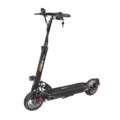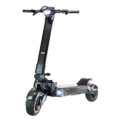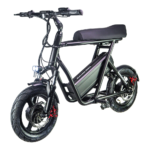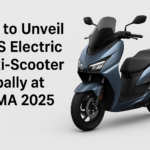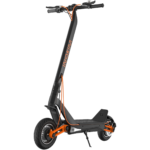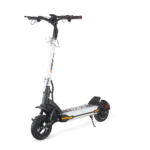- Home
- Scooters
- Electric Scooters
- EMOVE RoadRunner SE
EMOVE RoadRunner SE
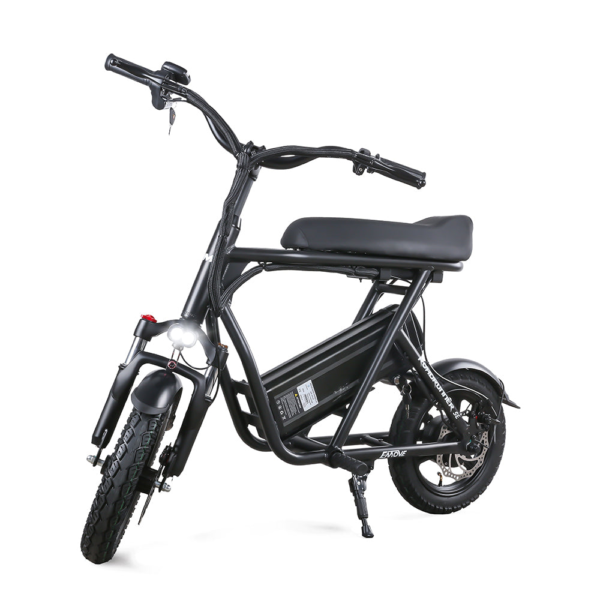

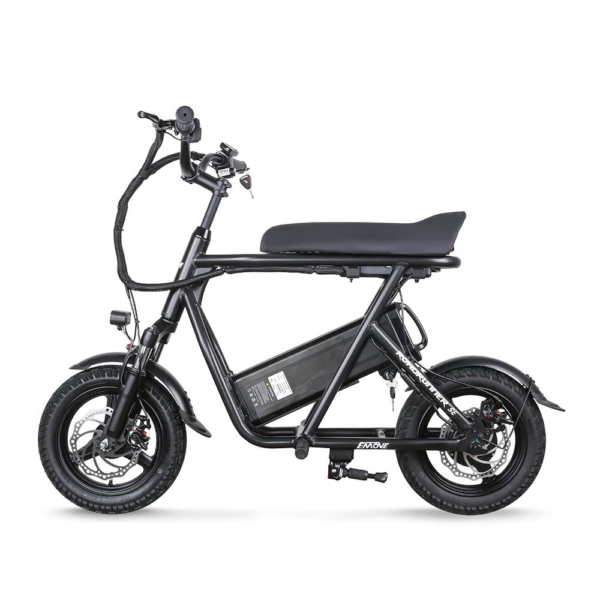

- Battery Range: 20 miles (32 km)
- Top Speed: 20 mph (32 km/h)
- Motor Power: 350W rear
- Weight Capacity: 330 lb (149.7 kg)
- Charging Time: 5 hours
- Scooter Weight: 50 lb (22.7 kg)
PROS
- Light 50 lb (22.7 kg) build
- Removable 36V 10.4Ah battery
- 14″ pneumatic tires
- Front adjustable suspension
- Keyed ignition & battery lock
CONS
- Short 20 mi (32 km) range
- Single 350W motor limits hills
- No official IP rating
Key Takeaways
- The EMOVE RoadRunner SE is a comfortable, seated electric scooter ideal for short trips and daily errands.
- It features a lightweight frame, a 350 W hub motor, and a removable battery for convenience and ease of use.
- The scooter provides a top speed of 20 mph and a range of about 20 miles under optimal conditions.
- Safety features include mechanical disc brakes, lighting, and a stable riding experience with 14-inch tires.
- The EMOVE RoadRunner SE suits new riders and multi-modal commuters but isn’t intended for high speeds or steep hills.
Table of contents
- What Is the EMOVE RoadRunner SE?
- How the EMOVE RoadRunner SE Works
- Key Specifications
- Design & Build Quality
- Performance Fundamentals
- Battery, Range & Efficiency
- Ride Quality & Comfort
- Braking & Safety Features
- Portability & Daily Usability
- Maintenance & Care
- Weather & Seasonal Considerations
- EMOVE RoadRunner SE vs Alternatives
- Who the EMOVE RoadRunner SE Is (and Isn’t) For
- FAQs
- Glossary
The EMOVE RoadRunner SE is a compact, seated electric scooter for short trips and daily errands. It keeps the learning curve low and the upkeep simple. If you want a stable ride, a swappable battery, and bicycle-style controls, you’ll feel at home fast.
So it leans toward comfort and practicality over raw speed. It fits first-time owners, students, and multi-modal commuters who care about range you can carry and a frame that parks in tight spaces.
What Is the EMOVE RoadRunner SE?
The EMOVE RoadRunner SE is the most approachable model in the RoadRunner line. It pairs a light chassis with a single rear hub motor and a removable, key-locked battery. You sit on a cushy memory-foam saddle, rest your feet on folding pegs, and steer with wide bars. The vibe is small moped, not stand-up kick scooter, yet it stays light enough to load into a car.
And it tops out near city bike pace with steady manners. The focus is comfort, safety, and predictable control rather than thrills. That’s the point. You get 14-inch tires for stability, a clear LCD with keyed ignition, and front and rear disc brakes for simple, familiar stopping.
How the EMOVE RoadRunner SE Works
The setup is straightforward. A rear hub motor does the driving. Power comes from a 36-volt lithium-ion pack that slides out of the tail and locks with a key. A sinewave controller meters current to the motor, so throttle inputs feel smooth, not jumpy. You twist the right grip to go, and you pull the brake levers to stop.
Think of it like a small ebike drivetrain. The battery is the fuel tank. The controller acts like the carb and ECU in one. The motor sits in the rear wheel’s hub. Since there’s no chain, the drive runs quiet and clean. And the big tires roll over patched city streets without much drama.
Then the mechanical disc brakes clamp 180 mm rotors at both ends. So lever feel is familiar if you’ve ridden bicycles or mopeds. Lights and turn signals help you get seen. And the keyed display handles power-on, basic settings, and trip readouts.
Key Specifications
| Block | Item | Value |
|---|---|---|
| General | Model | EMOVE RoadRunner SE |
| Vehicle Type | Seated electric scooter | |
| Frame Material | 6061 aluminum alloy | |
| Colors | Black, White | |
| Performance & Power | Top Speed | 20 mph (32 km/h) |
| Hill Climb | 15° claimed | |
| Motor | Rear hub, 350 W nominal / 500 W peak | |
| Controller | 36 V, 20 A sinewave | |
| Battery, Charging & Electrical | Battery | 36 V, 10.4 Ah removable pack |
| Energy | ~374 Wh | |
| Charge Time | ~5 hours with standard charger | |
| Display | Key-locked LCD | |
| Throttle | Twist grip | |
| Build & Dimensions | Tires | 14 × 2.5 in pneumatic |
| Brakes | Mechanical discs, 180 mm rotors (front and rear) | |
| Seat | Memory-foam “Racer” style | |
| Unfolded Size | 50 × 25 × 38 in (127 × 63.5 × 96.5 cm) | |
| Folded Dimensions | Non-folding frame; pegs fold | |
| Vehicle Weight | ~50 lb (22.7 kg) | |
| Max Rider Load | 330 lb (150 kg) | |
| Safety & Control | Lighting | Headlight, brake light, turn signals |
| Water Protection | Light rain use (no stated IP code) | |
| Features & Extras | Battery | Lockable and swappable |
| Handlebars | Wide, bicycle-style cockpit | |
| Cruise Control | Not stated by the manufacturer | |
| Warranty & Compliance | Warranty | Manufacturer’s limited warranty |
| Electrical Compliance | UL status not stated |
Design & Build Quality
The 6061 aluminum frame keeps weight low and feels solid in normal use. The cockpit follows bicycle logic. You get wide bars for leverage, simple levers, and a twist throttle that most riders learn in minutes. The keyed LCD helps deter casual tampering. And the removable pack locks to the frame, which helps with storage and peace of mind.
The saddle is a highlight. It spreads pressure and softens road buzz from rough pavement. So longer rides feel easier than on a narrow ebike seat. The 14-inch tires steady the steering and cut twitchiness. Foot pegs fold to the sides when you park or load the scooter.
Wiring runs outside the frame for easy service. That choice trades a tidier look for quicker parts swaps. It matches the RoadRunner theme of simple, modular upkeep. So you can replace a display, brake lever, or headlight without a full teardown.
Performance Fundamentals
Twist the throttle and the scooter pulls away cleanly. Power builds in a smooth line, not a spike. So starts feel controlled near pedestrians or in tight spaces. The SE settles into its top speed with calm steering and no front-end shake when tires sit near proper pressure.
On rolling ground, the motor holds speed on gentle grades. Long hills around 7–10% will slow the scooter unless you bring momentum. So plan your lines early and keep a steady throttle on the slope. The wide bars help you track straight, and the seat lets you shift weight rearward for traction.
Then cruising shows its strengths. It keeps a steady pace on city streets and shared paths. Wind noise stays low. Vibration remains modest thanks to the large tires and a cockpit that filters small chatter. So you finish rides less fatigued than on small-wheel stand-up models.
Battery, Range & Efficiency
The removable 36 V, 10.4 Ah pack stores about 374 Wh. That pairs well with the single rear hub. Many riders see around 20 miles (32 km) in light city use. Rider weight, headwinds, tire pressure, and temperature all matter. So a 150–180 lb rider on flatter terrain will squeeze more miles than a heavier rider on hilly routes.
Speed habits matter too. Sit at the top of the speedometer and range dips. Leave a small buffer and you gain distance without adding much time. Then keep tires in their recommended pressure window. Soft tires waste energy. Hard tires reduce grip and comfort.
Charging is simple. Use the stock charger and plan around five hours from low. The pack slides out in seconds, which helps if your building bans charging in common areas. So you can bring the battery inside, charge on a stable surface, and pop it back in once cool.
Ride Quality & Comfort
First impression: stable. Big wheels track straight through cracks and patched asphalt. The wide bars add steering control at low speed. So tight turns and curb cuts feel less fussy.
The saddle carries real weight without hot spots. Memory foam spreads the load and trims buzz from coarse pavement. For many riders that means fewer breaks on longer rides. The upright posture helps you see traffic and stay seen.
Tires handle most of the suspension work. At city pressures they balance grip, comfort, and rolling resistance. So the scooter clears speed bumps and mild potholes without much fuss. On rougher patches, stand on the pegs for a moment, bend your knees, and let your legs absorb the hit.
Braking & Safety Features
Dual mechanical discs with 180 mm rotors bring strong bite and clear feedback. The first half of the lever stroke takes up slack. The second half gives the stop. Set lever reach so you can pull with one finger if you like. Then practice in a quiet lot until the feel becomes second nature.
Lighting is built in. A headlight helps you get noticed in daylight and see the road at dusk. Brake lights cue traffic behind you when you slow. Turn signals help with lane changes and driveway exits. So use them even on low-traffic streets. Visibility is your friend.
Riding in light rain is fine. Wipe the scooter dry after each wet trip and park under cover. There’s no published IP code. So avoid deep puddles, pressure washers, and heavy spray.
Portability & Daily Usability
At about 50 lb, the SE sits near the high end of “one-hand lift,” yet it’s manageable if you pull the battery. The frame doesn’t fold, which helps stability on the road. So plan storage with that in mind. Many owners roll it into a hallway, shed, or trunk with the saddle off.
Foot pegs fold in. That tiny detail cuts snags when you slide the scooter against a wall. The removable pack makes apartment life easier. Carry the battery upstairs, charge inside, and leave the chassis in a garage or storage cage.
Security needs a plan. Use a U-lock through the frame and a fixed anchor. Add a cable for the front wheel if you park outside. Then keep the battery and display key with you when the scooter is unattended.
Maintenance & Care
A short routine keeps the scooter tight and safe.
- Before each ride: Check tire pressure with a gauge. Spin the wheels and listen for rub. Test both brakes. Confirm the headlight and brake light work.
- Weekly: Inspect rotor bolts, caliper mounts, stem clamp, axle nuts, and peg bolts. Tighten to spec. Clean and lube pivot points if needed. Wipe the cockpit and check cable runs.
- Monthly: True rotors if you feel pulsing. Adjust cable tension at the caliper or lever to bring back firm bite. Check lever reach. Inspect tires for cuts and debris. Rotate wheels if wear looks uneven.
- Battery habits: Store around 40–80% when idle for a week or more. Charge in a cool, dry place on a stable surface. Let the pack rest after a ride before you plug in. So cells cool first.
- Display and settings: The LCD offers basic P-settings. Note your defaults, make small changes, then test ride after each tweak.
Weather & Seasonal Considerations
Rain cuts traction. So slow down, extend braking distances, and avoid paint lines. Keep fenders clean so spray doesn’t mask the brake light. Dry the scooter after a wet ride and store it under cover.
Heat isn’t friendly to batteries if you charge while cells are hot. So let the pack cool before charging on summer days. Cold trims range and grip. Plan shorter trips in winter and ride a few warm-up miles before you push speed.
Wind matters on open roads. A steady headwind can trim range by a clear margin. So pick routes with shelter from buildings and trees when you can. Then ride with smoother inputs to save energy.
EMOVE RoadRunner SE vs Alternatives
Inside the RoadRunner family, the SE is the easiest starting point. It trades top speed and dual-motor punch for lighter weight and lower stress. If you want more speed and range in the same brand, look at the EMOVE Cruiser V2 or the EMOVE Cruiser S, which tilt toward longer rides and stronger hill pace.
Against stand-up commuter scooters, the SE wins on comfort and stability. The seat reduces fatigue on longer rides. The big wheels roll over gaps and rough patches that can rattle small scooters. It’s less compact than a folding deck scooter though, so storage needs a bit more thought.
Against performance or off-road classes, the SE gives up peak speed and steep-hill torque. But it pushes back with easy handling and predictable braking. So a rider who values calm trips over thrill runs may still pick it even with bigger options available.
Who the EMOVE RoadRunner SE Is (and Isn’t) For
Best for:
- New riders who want bicycle-like controls and quick confidence
- Students who value comfort on campus and around town
- Short urban commutes under 10–12 miles round trip
- Multi-modal riders who want a seat and a swappable pack
- Owners who prefer cable brakes and easy DIY service
Not ideal for:
- Riders who want freeway-pace speeds
- Daily climbs on long, steep grades
- Apartment life that demands a fully folding frame
- Off-road exploring that needs suspension travel and knobby tires
FAQs
1) What is the real top speed and range?
Plan on about 20 mph (32 km/h) on level ground and roughly 20 miles (32 km) in light city use. Heavier riders, hills, cold, and high speeds will lower those numbers.
2) Can I swap the battery myself?
Yes. Turn the key to unlock, slide the pack out, and reverse the steps to install the charged pack. So you can carry a spare and double your range.
3) Does the scooter fold?
The frame does not fold. Foot pegs do. The seat and battery remove quickly, which helps with storage and loading.
4) What tire pressure should I run?
Start in the mid-to-high 30s psi for city use, then adjust a few psi at a time. Higher pressure rolls faster but rides firmer. Lower pressure adds grip and comfort but raises pinch-flat risk.
5) How steep a hill can it climb?
Short grades near 7–10% are fine if you bring speed into the slope. Long, steep hills will slow the scooter, so pick routes that spread elevation over distance.
6) Does it have cruise control?
The manufacturer does not list cruise control for this model. Hold speed with the twist throttle and ease off around traffic.
7) Where can I find a concise “EMOVE RoadRunner SE overview”?
You’re reading it. This guide covers the model’s role, core features, sizing, and care so you can decide with confidence.
Glossary
- Ah (amp-hours): A measure of battery capacity. More Ah means more stored charge.
- Wh (watt-hours): Voltage × amp-hours. A clear view of total energy.
- Controller: The box that meters current from the battery to the motor.
- Sinewave: A controller style that delivers smooth, quiet power.
- Hub motor: A motor built into a wheel hub that drives the wheel directly.
- Regen braking: Motor-based braking that sends power back to the pack. This model lists cable discs, not stated regen.
- Stem: The part that holds the bars. Here it’s fixed, not a folding joint.
- Stem flex: Small movement in the steering column under load. Less flex feels more precise.
- IP rating: A code for dust and water resistance. This scooter lists light rain use instead of a code.
- P-settings: Display settings for units, power levels, and ride behavior.
- Peak power: Short bursts above nominal power for acceleration.
- Nominal power: The motor’s continuous rating under standard conditions.
- Rotor: The steel disc that the caliper squeezes to slow the wheel.
- Torque: Turning force from the motor that helps on hills.
- UL certification: A safety standard for electrical systems. Not stated here.
Editorial Notes on Specs and Sizing
The figures in the table reflect the published specifications for this model. Parts can vary by batch and region. So check the battery label, controller rating, and tire type on your unit after delivery. If your routes or weather are harsh, plan a range buffer. Then log your first month of rides to learn your personal numbers.
Setup Tips for New Owners
- Inflate tires with a floor pump and check pressure weekly.
- Set lever reach so one or two fingers deliver full braking.
- Keep a 15–20% battery reserve in winter. Cells sag in the cold.
- Carry a hex key set and a mini pump on longer rides.
- Clean and dry the scooter after wet trips. Then store it inside.
Range Planning on Real Streets
Pick a route with gentle grades and fewer stop-starts. Then ride at a steady pace a touch below top speed. Use brake lights early to cue others. Aim for smooth lines through turns and leave space to react. Small gains in smoothness add up to real range.
Safety Habits That Stick
Wear a helmet every ride. Bright gloves help drivers see hand signals. Scan far ahead and plan two moves in advance. Then make eye contact and signal clearly. These habits raise your safety more than any single hardware upgrade.
Why This Model Endures
The RoadRunner idea lowers stress. You sit, you steer with wide bars, and you get big-wheel stability at human-scale speeds. The SE keeps that recipe and trims cost and complexity. So it welcomes new riders and leaves room to grow with a spare battery or cockpit tweaks.
It won’t replace a high-power dual-motor machine for steep towns or long highway-adjacent routes. Yet it brings more comfort than small stand-up scooters in the same weight class. And it delivers range that matches many short commutes without the bulk of a full ebike.
Common Upgrades
- Second battery: Doubles range for weekend loops.
- Brake pads: Higher-friction pads for stronger bite.
- Mirror and bell: Better awareness without lifting a hand.
- Tires: Puncture-resistant tubes or liners if your roads are dirty.
- Phone mount: Keep maps and speed visible.
Then use bolt-on parts and check clearances after each change. Re-torque fasteners after the first ride.
Final Thoughts
This EMOVE RoadRunner SE guide centers on control, comfort, and predictability. The scooter favors smooth pulls, easy service, and simple storage. So it meets the needs of riders who want a seated platform that just works, day after day, on short urban trips.
If that’s your use case, you’ll like the calm ride, the clear brake feel, and the removable battery. If you want high speed or steep-hill punch, you’ll look higher in the line. Even so, the SE gives new owners a friendly start with clear strengths and honest limits.
Specifications
General
| Model The Model specifies the exact version or name of the scooter. It helps identify its unique design, features, and specifications within the manufacturer’s product line. Knowing the model makes it easier to compare options, find compatible accessories, or look up support information. | RoadRunner SE |
| Brand The Brand identifies the manufacturer or company that designs and produces the scooter. A trusted brand is a sign of quality, reliability, and good customer support. Well-known brands often have higher standards for safety, performance, and after-sales service, giving you more confidence in your purchase. | EMOVE |
| Release Date The Release Date indicates when the scooter model was officially launched on the market. This helps you know how current the design, technology, and features are. A newer release date often means updated components, improved performance, and the latest safety or smart features. | 18 November 2025 |
| Recommended Age Recommended Age indicates the minimum age range that the scooter is designed for, based on safety, size, and ease of use. Following the recommended age helps ensure that riders can handle the scooter’s speed, weight, and controls comfortably and safely. Always check local laws and use protective gear, especially for younger riders. | +16 |
Performance & Power
| Motor Power (Wattage) What it means: The motor power, measured in watts (W), shows how strong the scooter’s electric motor is. Why it matters: Higher wattage usually means better acceleration, more torque, and improved performance on hills or rough terrain. For example, a 250W motor is good for flat city roads and light riders, while a 500W or 1000W motor provides more power for faster speeds or climbing steep inclines. | Single 350W rear hub motor (500W peak) |
| Top Speed The Top Speed indicates the maximum speed that the scooter can reach under optimal conditions. It’s usually measured on level ground with a fully charged battery and an average rider weight. A higher top speed allows you to travel longer distances faster, but always ensure you ride within legal speed limits and your personal comfort zone for safety. | 20 mph (32 km/h) |
| Battery Capacity Battery Capacity refers to the total amount of energy the scooter’s battery can store, usually measured in ampere-hours (Ah) or watt-hours (Wh). A higher battery capacity means you can ride longer distances on a single charge, reducing the need for frequent recharging. Keep in mind that actual range can vary depending on rider weight, terrain, speed, and weather conditions. | 36 V 10.4 Ah (374 Wh) |
| Estimated Range per Charge The Estimated Range per Charge indicates the average distance the scooter can travel on a single full battery charge. This range is calculated under optimal conditions, such as flat terrain, moderate speed, and average rider weight. Real-world range may vary depending on riding style, terrain, weather, and load. A longer range means fewer recharges and greater freedom for longer trips. | 20 miles (32 km) |
| Hill Climb Ability Hill Climb Ability describes the maximum incline or slope that the scooter can handle while maintaining stable performance. It’s typically expressed as a percentage or in degrees. A higher hill climb rating means the scooter can tackle steeper hills without losing too much speed or power. Actual climbing performance may vary based on rider weight, battery charge, and terrain conditions. | 15° |
| Drive System The Drive System refers to how power from the motor is delivered to the wheels. Electric scooters typically use either a hub motor (directly integrated into the wheel) or a chain/belt drive system. A high-quality drive system ensures smooth acceleration, efficient power transfer, and low maintenance. The choice of drive system affects performance, noise level, and overall ride experience. | RWD (rear hub) |
Charging & Electrical
| Charging Time Charging Time indicates how long it takes to fully recharge the scooter’s battery from empty to 100% using the standard charger provided. Faster charging means less downtime and more time on the road. Actual charging time may vary slightly depending on battery capacity, charger output, and environmental conditions. | 5 hours |
| Battery Type Battery Type refers to the specific technology used in the scooter’s battery, which affects performance, lifespan, weight, and charging time. Most modern electric scooters use high-quality lithium-ion (Li-ion) batteries because they offer a good balance of energy density, durability, and low maintenance. A reliable battery type ensures consistent power delivery and longer riding ranges. | Lithium-ion pack with BMS |
| Removable Battery A Removable Battery means the battery pack can be easily detached from the scooter for convenient charging and replacement. This feature allows you to charge the battery separately, swap it with a spare for extended range, or securely store it indoors in extreme weather. Removable batteries add flexibility and make it easier to keep your scooter powered up wherever you are. | Yes |
| Regenerative Braking Regenerative Braking is an energy-saving feature that converts some of the energy normally lost during braking back into battery power. When you slow down or brake, the motor works in reverse to generate electricity, which helps extend the scooter’s range and improves overall efficiency. This system also reduces wear on traditional brake components, leading to lower maintenance over time. | Not specified |
| Lighting Lighting refers to the built-in front and rear lights that enhance visibility and safety when riding in low-light conditions or at night. Good lighting helps you see the road ahead and ensures that other road users can see you. Many scooters include LED headlights, taillights, and sometimes brake lights or side reflectors for added safety and compliance with local traffic regulations. | LED headlight; rear brake + turn signals |
Build & Dimensions
| Scooter Weight Scooter Weight refers to the total weight of the scooter when fully assembled, including the battery. This affects how easy it is to carry, lift, and store the scooter when not in use. A lighter scooter is more portable and convenient for commuting, especially if you need to carry it upstairs or onto public transport. Keep in mind that a sturdy frame and quality components may add to the weight but also contribute to better durability and ride stability. | 50 lb (22.7 kg) |
| Maximum Rider Weight Maximum Rider Weight indicates the highest rider weight that the scooter is designed to safely support while maintaining optimal performance and stability. Staying within this limit helps ensure reliable acceleration, braking, and climbing ability, and it protects the frame, suspension, and motor from excessive strain. Exceeding the recommended limit may reduce performance and increase wear on components. | 330 lb (149.7 kg) |
| Deck Size Deck Size refers to the dimensions of the scooter’s standing platform. A wider and longer deck provides more foot space, allowing you to stand comfortably and adjust your stance while riding. A well-sized deck improves balance and stability, especially on longer rides or at higher speeds. Compact decks, on the other hand, help keep the scooter lightweight and portable. | Seated mini-bike; folding handlebars |
| Handlebar Height Handlebar Height refers to the distance from the deck to the handlebars, which affects your riding posture and comfort. An appropriate handlebar height helps you maintain good balance, reduces strain on your back and arms, and makes steering more comfortable. Some scooters have adjustable handlebars to fit riders of different heights, while others have a fixed height for a streamlined design. | Adjustable |
| Folding Mechanism The Folding Mechanism describes how easily and securely the scooter can be folded for carrying and storage. A well-designed folding system lets you quickly collapse the scooter into a compact size, making it convenient to transport on public transit, store under a desk, or fit into a car trunk. Look for sturdy latches and safety locks to ensure the scooter stays firmly in place when folded or unfolded. | Folding handlebars; fixed frame |
| Dimensions Folded Dimensions indicate the size of the scooter when it’s fully folded. This measurement shows how much space the scooter will take up when stored or carried, making it easier to check if it will fit in your car trunk, under a desk, or in a closet. Compact folded dimensions are ideal for commuters who need to bring their scooter on public transport or store it in tight spaces. | 50" (L) x 25" (W) x 38" (H); Folded: Not specified |
| Material Material refers to the primary construction materials used for the scooter’s frame and key components. High-quality materials like aircraft-grade aluminum, reinforced steel, or durable composites provide strength, stability, and a lighter overall weight. A sturdy material ensures the scooter can handle daily wear and tear while maintaining safety and performance. | 6061 aluminum alloy |
Safety & Control
| Brake Type(s) Brake Type(s) describe the braking systems the scooter uses to help you slow down or stop safely. Common brake types include mechanical brakes (like drum or disc brakes), electronic brakes, and foot brakes. Many scooters combine multiple braking systems for added safety and shorter stopping distances. The type and quality of brakes affect your control, especially when riding at higher speeds or on slopes. | Mechanical discs (180 mm) |
| Suspension Suspension refers to the system that absorbs shocks and vibrations while riding, providing a smoother and more comfortable ride over uneven or rough surfaces. Scooters may have front suspension, rear suspension, or dual suspension for better shock absorption and stability. Good suspension helps reduce rider fatigue and improves control, especially when riding on bumpy roads or off-road paths. | Front adjustable; rear: none |
| Tire Type Tire Type refers to the kind of tires the scooter uses, which directly affects ride comfort, traction, and maintenance. Common types include solid (airless) tires, pneumatic (air-filled) tires, or hybrid options. Pneumatic tires offer better shock absorption and a smoother ride on rough surfaces, while solid tires are puncture-proof and require less upkeep. The right tire type helps ensure safe handling and a comfortable ride in different conditions. | 14" x 2.5" pneumatic (inner tube) |
| Tire Size Tire Size indicates the diameter and width of the scooter’s tires, which affect ride comfort, stability, and how well the scooter handles different terrains. Larger tires generally offer better shock absorption and a smoother ride over bumps and rough surfaces, while smaller tires keep the scooter lighter and more portable. Choosing the right tire size helps ensure a balance between agility and comfort. | 14-inch |
| Kickstand The Kickstand is a built-in stand that allows you to park your scooter upright when it’s not in use. A sturdy kickstand keeps the scooter stable and prevents it from tipping over, protecting it from scratches and damage. It also makes storing and accessing your scooter more convenient, whether you’re at home, work, or on the go. | Side kickstand |
| Water Resistance Rating Water Resistance Rating indicates how well the scooter is protected against water and moisture, usually shown as an IP (Ingress Protection) rating. This rating helps you understand whether the scooter can handle light rain, splashes, or wet roads without damage. While most scooters are not fully waterproof, a good water resistance rating adds peace of mind when riding in changing weather conditions. Always avoid deep puddles or submerging the scooter to protect its electrical components. | Not specified |
Features & Extras
| Display/Console The Display (or Console) shows important real-time information about your ride, helping you monitor your scooter’s status at a glance. Typical displays show speed, battery level, distance traveled, and riding mode. Some models also include additional features like Bluetooth connectivity, app integration, or backlighting for better visibility at night. A clear and easy-to-read display enhances safety and convenience on every trip. | Key-locked LCD |
| Ride Modes Ride Modes refer to the different speed and power settings you can choose to match your riding style or road conditions. Common modes include eco for maximum range and energy efficiency, standard for everyday balance, and sport or turbo for higher speed and stronger acceleration. Switching between ride modes allows you to customize performance, conserve battery, and ride safely in various environments. | 3 modes |
| Smart App Connectivity Smart App Connectivity lets you pair your scooter with a dedicated mobile app via Bluetooth. Using the app, you can monitor real-time ride stats like speed, battery level, and range, adjust settings such as ride modes or cruise control, lock the scooter for added security, and sometimes receive firmware updates. This feature adds convenience and allows you to personalize your riding experience right from your smartphone. | None |
| Anti-Theft System The Anti-Theft System helps protect your scooter from unauthorized use or theft. This feature can include built-in alarms, electronic motor locks, GPS tracking, or remote locking through a mobile app. A good anti-theft system provides peace of mind when parking your scooter in public spaces, adding an extra layer of security to safeguard your investment. | Keyed ignition + lockable battery mount |
| Cruise Control Cruise Control allows you to maintain a steady speed without continuously holding the throttle. This feature makes longer rides more comfortable by reducing hand fatigue and providing a smoother, more relaxed riding experience — especially on flat, open roads or bike lanes. For safety, cruise control can usually be easily activated or deactivated while riding. | Not specified |
| Accessories Included Accessories Included lists the additional items that come with the scooter to enhance your riding experience and convenience. Common accessories may include a charger, kickstand, bell, lights, phone holder, or carrying strap. These extras add value by making your scooter safer, easier to use, and ready to ride straight out of the box. | Scooter, charger, toolkit, manual |
Warranty & Compliance
| Warranty Period The Warranty Period indicates how long the manufacturer guarantees the scooter against defects in materials and workmanship under normal use. A good warranty provides peace of mind, showing the brand’s confidence in its product quality. Always check what parts are covered, such as the frame, battery, and motor, and follow the maintenance guidelines to keep your warranty valid. | 12 months (region-dependent) |
| Certifications Certifications confirm that the scooter meets specific safety, quality, and environmental standards set by recognized organizations or regulatory bodies. Common certifications may include CE, RoHS, UL, or other local compliance marks, depending on your region. These certifications ensure that the scooter is manufactured to high standards and is safe and legal to use in your country. | Region-dependent micromobility regulations |


